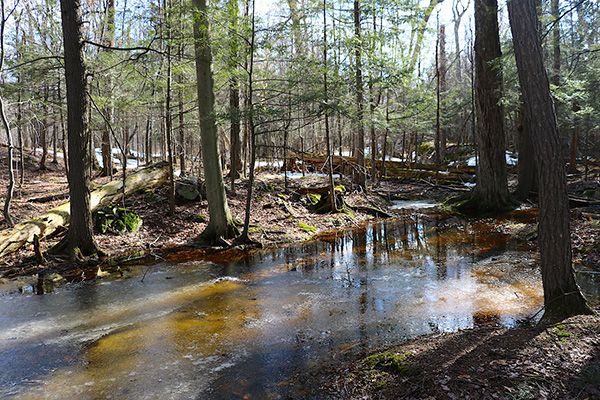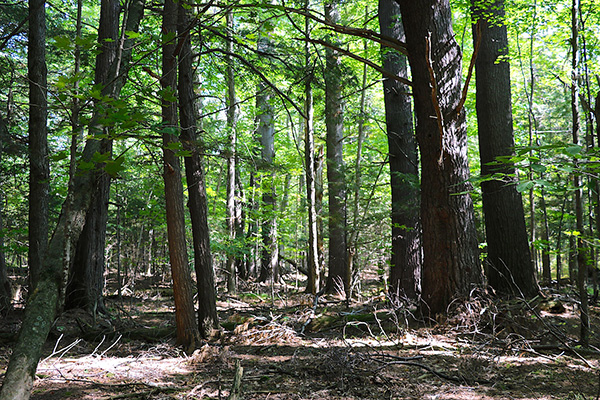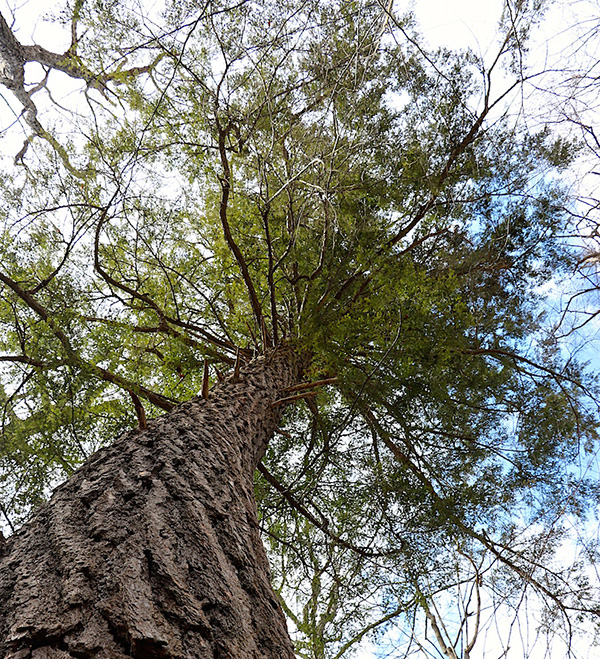The 110 acre Poole Family Nature Sanctuary is the latest addition to MMLT’s property portfolio, bringing the total area protected to 2,664 ac. (11 km2/4 mi2). It is located at 318 Concession 11 of Drummond Twp., one of the concession roads mapped out around 1816 when the Perth Military Settlement was established. It was purchased by the Poole family in 1850 and has remained largely wooded since that time, likely because of the shallow soil and rocky conditions.
This beautiful property was donated to MMLT by Helen White. Helen told us, “My father was the fourth generation of his family to own it. Family history and heritage were my father’s passion. He loved the land and nature and was fiercely proud of his bush lot – that no trees had been cut since the 1950s. He instilled the same love of nature in me, which I hope I have passed on to my family.”
“With my father’s passing, there were no males to carry on the family name in this area. So, I have requested that the property be named the Poole Family Nature Sanctuary to honor my father and keep the family name alive in this area, being assured that it will be cared for in perpetuity, while allowing others to experience the joys of nature.”

An ephemeral or vernal pond, which is a temporary pool of water that provides habitat for distinctive plants and animals.
This Ecological Gift property is adjacent to the 530 acre Keddy Nature Sanctuary, bringing the total contiguous protected area to 640 ac. It contains part of the Scotch Corners Provincially Significant Wetland Complex.
The wetlands, interspersed with forest, include species-rich marshes; deciduous, mixed and coniferous swamps; vernal pools; and seepage areas. The swamps are characterized by green ash, yellow birch, black ash, red maple, blue beech, white cedar and balsam fir. Moss-covered logs are frequent in the understory. One swamp is exceptionally rich in fern species (14)—maidenhair fern, ostrich fern, northern oak fern, lady fern, sensitive fern, cinnamon fern, bulblet fern, crested woodfern, royal fern, marginal shield fern, marsh fern, northern beech fern, spinulose woodfern, silvery spleenwort. Osprey and great blue herons have been observed in the marsh.
The well-developed upland forest is composed of sugar maple, ironwood, basswood, red oak, white pine, and hemlock with a scattering of bitternut hickory, beech, white birch, and red maple. Some hemlock, green ash, white pine and sugar maple stands are well over 150 years old. Many trees in the grove of old growth white pine are at least 37 m tall, with one over 40 m—comparable to those in Gillies Grove (Arnprior), owned by the Nature Conservancy of Canada. Hemlock trees may reach 30 m—like those at Arnprior or in Shaw Woods (20 km S of Pembroke). All three species of elm known from the area are found here—rock (44 cm diameter), American, slippery.
Currently we know the property provides habitat for five species at risk (butternut, snapping turtle, painted turtle, monarch butterfly, eastern wood pewee) and 28 plant species significant in Lanark County. Additional noteworthy discoveries may be made this summer as MMLT conducts field inventory to support the preparation of a property Baseline Documentation Report. This BDR will provide the foundation for developing a property stewardship plan in 2019.
Approximately 8 km west of Carleton Place on Highway #7, turn south on Scotch Corners Rd. and travel 5.2 km. Turn right on the 11th Line Beckwith which soon becomes Drummond Con. 11 and travel 1.3 km. The trailhead is located at # 318


